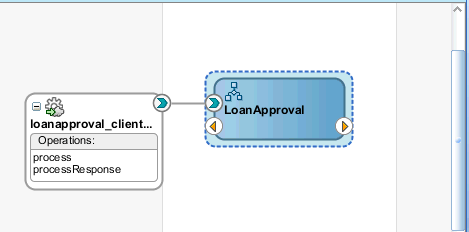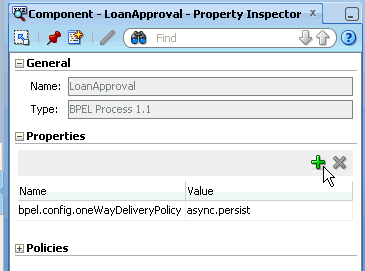C Deployment Descriptor Properties
This appendix includes the following section:
For more information about deployment descriptor properties, see Chapter "Oracle BPEL Process Manager Performance Tuning" of Tuning Performance.
C.1 Introduction to Deployment Descriptor Properties
Deployment descriptors are BPEL process service component properties used at runtime by Oracle WebLogic Server, Oracle Enterprise Manager Fusion Middleware Control, or both. There are two types of properties:
-
Configuration
-
Partner link binding
Table C-1 lists the configuration deployment descriptor properties.
When you define configuration properties, you must add a prefix of bpel.config to the property name. For example, the property inMemoryOptimization must be defined as bpel.config.inMemoryOptimization. For information on defining properties in the Property Inspector in Oracle JDeveloper, see How to Define Deployment Descriptor Properties in the Property Inspector.
Table C-1 Properties for the configurations Deployment Descriptors
| Property Name | Description |
|---|---|
|
|
This property configures how the instance data is saved. It can only be set at the BPEL service component level. The following values are available:
|
|
|
This property, when set to |
|
|
If using outbound adapters in an asynchronous BPEL process, specify the maximum number of retries for a remote fault. |
|
|
If using outbound adapters in an asynchronous BPEL process, specify the time interval in milliseconds between retries for a remote fault. |
|
|
Default value is |
|
|
Specify whether the server can keep global variable values in the instance store when the instance completes:
|
|
|
This property sets the persistence policy of the process in the delivery layer. The possible values are:
For information about setting this property during BPEL process creation, see How to Add a BPEL Process Service Component. For more information, see Section "Tuning Database Persistence for BPEL" of Tuning Performance. |
|
|
This property controls the number of instances to create and use to route messages. The possible values are:
For more information, see Routing Messages to the Same Instance. |
|
|
The location of the sensor action XML file. The sensor action XML file configures the action rule for the events. |
|
|
The location of the sensor XML file. The sensor XML file defines the list of sensors into which events are logged. |
|
|
This property configures the transaction behavior of the BPEL instance for initiating calls.
Note: This property does not apply for midprocess receive activities. In those cases, another thread in another transaction is used to process the message. This is because a correlation is needed and it is always done asynchronously. For information about setting this property during BPEL process creation, see How to Add a BPEL Process Service Component. |
Table C-2 lists the partner link binding deployment descriptor properties.
When you define partner link binding properties, you must add a prefix of bpel.partnerLink.partner_link_name to the property name. For example, the property nonBlockingInvoke must be defined as bpel.partnerLink.partner_link_name.nonBlockingInvoke. For information on defining properties in the Property Inspector in Oracle JDeveloper, see How to Define Deployment Descriptor Properties in the Property Inspector.
Table C-2 Properties for the partnerLinkBinding Deployment Descriptors
| Property Name | Description |
|---|---|
|
|
An idempotent activity is an activity that can be retried (for example, an assign activity or an invoke activity). The instance is saved after a nonidempotent activity. This property is applicable to both durable and transient processes.
For more information about the |
|
|
Default value is For more information, see What You May Need to Know About the Execution of Parallel Flow Branches in a Single Thread. |
|
|
Enables message boundary validation. When set to |
C.1.1 How to Define Deployment Descriptor Properties in the Property Inspector
You define configuration and partner link binding deployment descriptor properties and values in the Property Inspector of Oracle JDeveloper. When complete, the properties are displayed in the BPEL process service component section of the composite.xml file.
<component name="LoanApproval" version="2.0"> . . . <componentType> . . . . . . <property name="bpel.config.oneWayDeliveryPolicy" type="xs:string" many="false">async.persist</property> </componentType> </component>
If you instead define a partner link binding deployment descriptor property in the Property Inspector (for example, the nonBlockingInvoke partner link binding property), it is displayed in the composite.xml file, as shown in the example that follows. Note the prefix of bpel.partnerLink.partner_link_name, which is required for this type of property.
<component name="myBPELServiceComponent" version="2.0">
. . .
<componentType>
. . .
. . .
<property name="bpel.partnerLink.partner_link_name.nonBlockingInvoke">
false</property>
</componentType>
</component>C.1.2 How to Get the Value of a Preference within a BPEL Process
The value of a property can be read by a BPEL process using the XPath extension function ora:getPreference(myPref). This gets the value of bpel.preference.myPref.
This function can be used as part of a simple assign statement, used in condition expressions, or used as part of a more complex XPath expression.

